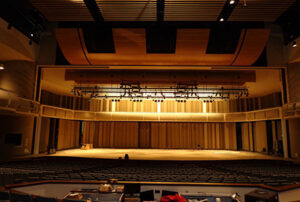Stage and theatre productions require precise coordination to deliver smooth, well-paced performances. Motorized stage rigging allows you to move lighting, scenery, speakers and equipment repeatedly and consistently.

Components of Motorized Stage Rigging
Each element of a motorized rigging system is designed to safely move suspended elements above or across the performance space.
Motorized rigging components include:
Battens: Metal pipes suspended by lift lines above the stage to hold up the fly system, curtains and other equipment.
Lines: Ropes or cables that secure and move hanging equipment, blocks and pulleys along the battens.
Anchor: A connection point that fastens lines to the battens.
Pulley or block: A mechanism to lift lines and absorb the force required to raise and lower stage components.
Sheave: A grooved wheel within a pulley that guides the line and prevents tangling.
Hook: A fixture that connects lines to anchors and loads.
Hoist: An electronic mechanism that moves loads above the stage.
Control panel: Computerized panels that control rigging system movement.
How Motors Drive Stage Rigging
You can program lighting, scenery and curtain movements without the use of counterweights in a motorized rigging system. The control panel sends electrical signals to the hoist motor which powers the rigging system. The gearbox adjusts the speed and torque of the motor, transferring power to the lift mechanism to raise or lower lines.
Safety Features
Motorized rigging allows you to make controlled movements of overhead equipment to protect performers, stagehands and audience members. That type of fly system also eliminates the need for manual rigging, which reduces the risk of human error and injury.
Motorized rigging must be installed properly and inspected regularly to ensure correct operation. Since these structures are complex, stagehands should receive thorough training before handling fly system equipment.
Many motorized rigging systems include emergency stop buttons, limit switches and load sensors to protect those on stage.
Maintenance Tips for Motorized Rigging Systems
- Inspect rigging lines for fraying and battens for bends or damage.
- Clean dirty components and lubricate gears, bearings and chains regularly.
- Check connection points and tighten bolts and fasteners that can loosen over time.
- Test limit switches to ensure rigging elements don’t travel too far.
- Conduct periodic load tests to verify the rigging can handle its rated capacity.
- Inspect motor alignment to look for premature wear and tear.
- Record all maintenance, inspections and repairs.
Types of Motorized Stage Rigging Applications
Curtains: Motorized rigging allows for both vertical and horizontal movement of curtains, including valances, travelers, borders, legs and scrims. Automating that motion enhances performances and set changes.
Scenery: The higher load capacity of motorized rigging permits more extensive set designs. You can use a greater number of backdrops and set pieces to create a more dynamic visual experience.
Special effects: Position special effects equipment such as fog machines and pyrotechnics securely. Then, use motorized rigging systems to activate and adjust those elements.
Lighting: Automate lighting changes to create smooth transitions between scenes and performances. Motorized rigging reduces the need for manual lighting adjustments and optimizes the space above the stage.
Audio: You can raise, lower and position speakers. Securing that type of heavy equipment is essential to performer and crew safety.
Motorized Rigging Systems from Tiffin Scenic Studios
We offer a variety of motorized hoist systems for theatre and stage productions. Our products range from push buttons to computerized panels. We also specialize in installation and inspections.
Contact us to learn more about how we can help you and your productions shine.